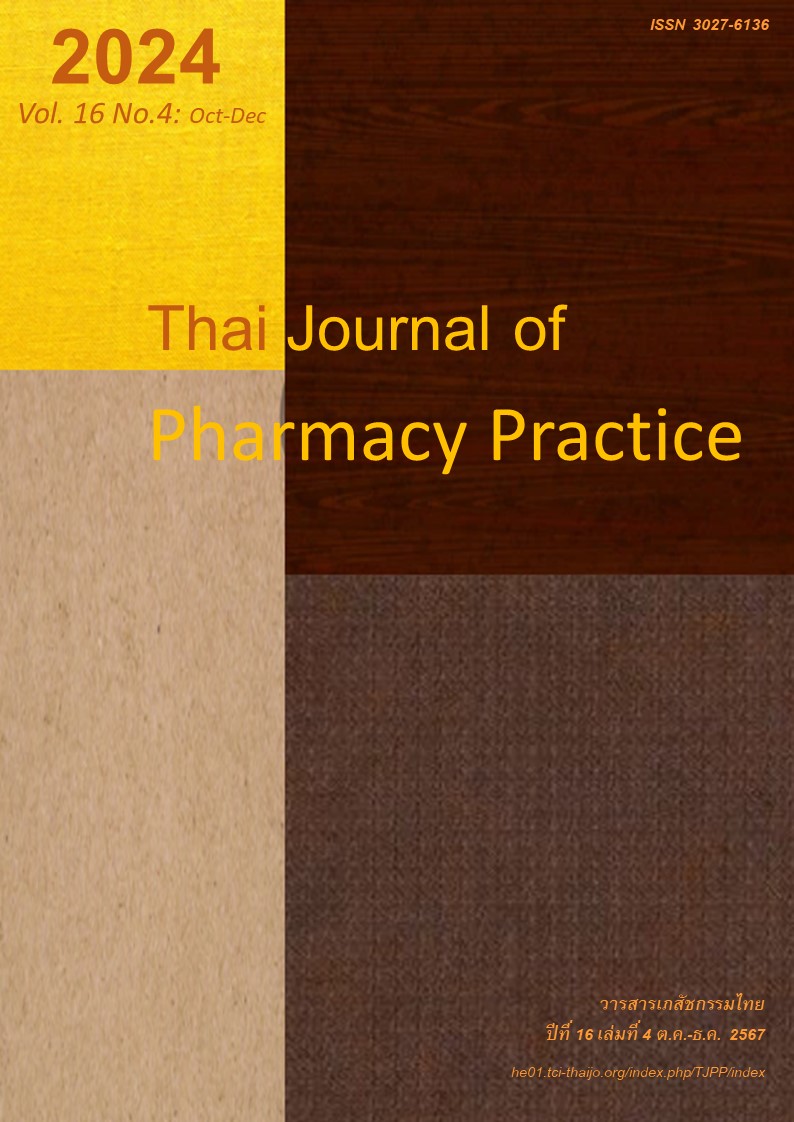การพัฒนาระบบการบริหารยาคงคลังที่มีประสิทธิภาพสำหรับโรงพยาบาลเมืองพัทยา
Main Article Content
บทคัดย่อ
วัตถุประสงค์: เพื่อพัฒนาระบบการบริหารยาคงคลังให้เหมาะสมกับโรงพยาบาลเมืองพัทยา วิธีการ: การศึกษาเชิงพรรณนาครั้งนี้คัดเลือกยา 3 กลุ่ม กลุ่มละ 3 รายการ ได้แก่ 1) ยากลุ่มที่มีมูลค่าการใช้สูง (ยากลุ่ม A ในการจัดกลุ่มยาแบบ ABC) และมีความสำคัญต่อการรักษามาก (ยากลุ่ม V ในการจัดกลุ่มยาแบบ VEN) หรือเรียกว่ายากลุ่ม AV 2) ยากลุ่มที่มีปริมาณการใช้มาก และ 3) ยากลุ่มที่ขาดคลังบ่อย การศึกษาจัดทำแบบจำลองสถานการณ์ที่มีการกำหนดปริมาณยาคงคลังต่ำสุดเพื่อเติมเต็มคลังยา โดยพารามิเตอร์ในแบบจำลองประกอบด้วยระยะเวลานำ ปริมาณการใช้ยาที่พยากรณ์จากค่าเฉลี่ยเคลื่อนที่อย่างง่าย 3 เดือนย้อนหลัง และระดับการให้บริการหรือความสามารถในการจ่ายยาให้ได้ครบตามจำนวนที่เบิก ผู้วิจัยเก็บข้อมูลราคาต้นทุนยา ปริมาณการใช้ยาจริง ปริมาณยาคงคลัง และค่าพยากรณ์ปริมาณการใช้ยาเฉลี่ยต่อเดือนโดยใช้ข้อมูลย้อนหลัง 3 ปีงบประมาณ การประเมินตัวชี้วัดประสิทธิภาพการบริหารยาคงคลังทำใน 3 ด้าน ได้แก่ มูลค่ายาคงคลังเฉลี่ยต่อเดือน อัตราหมุนเวียนยาคงคลังต่อปี และระดับการให้บริการ ผลการวิจัย: เมื่อเปรียบเทียบกับแบบจำลองสถานการณ์ปัจจุบัน พบว่า ภายใต้แบบจำลองที่ใช้วิธีการหาค่าเฉลี่ยเคลื่อนที่อย่างง่าย การบริการยาคงคลังมีการกำหนดค่าระดับยาคงคลังต่ำสุด โดยมีระยะเวลานำที่ 0.5 เดือน และระดับบริการที่ร้อยละ 100 เหมาะสมที่สุดสำหรับยาทั้ง 3 กลุ่ม โดยสามารถทำให้ตัวชี้วัดประสิทธิภาพการบริหารยาคงคลังทั้ง 3 ด้านดีที่สุด โดยพบว่าทำให้มูลค่ายาคงคลังเฉลี่ยต่อเดือนลดลงร้อยละ 8.6-24.5 ด้านอัตราหมุนเวียนยาคงคลังเฉลี่ยต่อปีเพิ่มขึ้นร้อยละ 9.4-32.8 ในยาทั้ง 3 กลุ่ม แต่อย่างไรก็ตาม ยากลุ่มที่มียาขาดคลังบ่อย เมื่อกำหนดระยะเวลานำที่ 0.5 เดือน พบว่า ปริมาณยาคงคลังต่ำสุดที่กำหนดไม่เพียงพอต่อปริมาณการใช้ยาส่งผลให้ระดับการให้บริการลดลงอยู่ที่ร้อยละ 97.22 สรุป: การประยุกต์นโยบายการบริหารยาคงคลังแบบต่อเนื่องร่วมกับการใช้เทคนิคการพยากรณ์ด้วยค่าเฉลี่ยเคลื่อนที่อย่างง่าย และระยะเวลานำที่ 0.5 เดือน มีความเหมาะสมสำหรับยากลุ่ม AV ยากลุ่มที่มีปริมาณการใช้มาก และยาที่มีการขาดคลังบ่อย วิธีนี้ทำให้ตัวชี้วัดประสิทธิภาพการบริหารยาคงคลังดีขึ้น สามารถลดมูลค่ายาคงคลังเฉลี่ยต่อเดือน เพิ่มอัตราหมุนเวียนยาคงคลังเฉลี่ยต่อปี และรับประกันระดับการให้บริการที่ร้อยละ 100 สำหรับยากลุ่ม AV ยากลุ่มที่มีปริมาณการใช้มาก แต่อย่างไรก็ตามระดับการให้บริการของยากลุ่มที่ขาดคลังบ่อยลดลง เภสัชกรจึงควรพิจารณาข้อมูลของปริมาณการใช้ยาที่มากที่สุดในอดีตเพื่อนำมากำหนดปริมาณยาคงคลังต่ำสุดและสูงสุด
Article Details

อนุญาตภายใต้เงื่อนไข Creative Commons Attribution-NonCommercial-NoDerivatives 4.0 International License.
ผลการวิจัยและความคิดเห็นที่ปรากฏในบทความถือเป็นความคิดเห็นและอยู่ในความรับผิดชอบของผู้นิพนธ์ มิใช่ความเห็นหรือความรับผิดชอบของกองบรรณาธิการ หรือคณะเภสัชศาสตร์ มหาวิทยาลัยสงขลานครินทร์ ทั้งนี้ไม่รวมความผิดพลาดอันเกิดจากการพิมพ์ บทความที่ได้รับการเผยแพร่โดยวารสารเภสัชกรรมไทยถือเป็นสิทธิ์ของวารสารฯ
เอกสารอ้างอิง
Leelathanapipat J, Chantuk T. Professional inventory management. Veridian E-Journal Science and Technology Silpakorn University. 2018; 11: 226-41.
Leelawaetpong C, Sotangkur K. Efficiency study of pharmaceutical administration pharmacy Charoen krung Pracharak hospital. Journal of Charoenkrung Pracharak Hospital. 2014; 7: 1-14.
Lertwattanawimon T. The inventory development of inventory management system for medical laboratory in hospital [master thesis]. Bangkok: Chulalongkorn University; 2011.
Chaiveerathai S, Liampreecha W. Optimization and cost reduction of pharmaceutical inventory manage ment: a case study of a government hospital in Phitsanulok. Journal of Community Development Research (Humanities and Social Sciences). 2015; 8: 139-53.
Banthao J. Inventory management of drugs and medical supplies: a case study of community hospital in Nakhon Ratchasima [master thesis]. Nakhon Ratchasima: Rajamangala University of Technology Isan; 2016.
Suksrisomboon C. The development of an inventory management system for the Royal Thai Air Force medical depot [master thesis]. Bangkok: Chulalong- korn University; 2007.
Laeiddee C. Improvement of re-order point for drug inventory management at Ramathibodi hospital [master thesis]. Bangkok: Mahidol University; 2010.
Techajumlernsuk B, Yotsombut K. ABC-VED analysis in pharmaceutical inventory management [online]. 2018 [cited Jun 8, 2020]. Available from: ccpe.pharmacycouncil.org/index.php?option=article_detail&subpage=article_detail&id=477.
Ilma NR, Mursyid HB. Pharmaceutical inventory management issues in hospital supply chains. Management 2013; 3: 1-5. doi: 10.5923/j.mm.20130 301.01.
Mahatme MS, Dakhale GN, Hiware SK, Shinde AT, Salve AM. Medical store management: an integrated economic analysis of a tertiary care hospital in Central India. J Young Pharm 2012; 4: 114-8.
Lumnoi P. The development of inventory manage ment system; case study of the pharmacy department of fort Navamintharachinee hospital [master thesis]. Chonburi: Burapa University; 2015.
Kritchanchai D, Meesamut W. Developing inventory management in hospital. Int J Supply Chain Manag 2015; 2: 11-9.
Pungsak A. Precision and effectiveness of demand forecasting for drug inventory management [master thesis]. Nakhon Pathom: Silpakorn University; 2015.
Kanakornyingyong N, Khompatraporn C. Forecas- ting various demand types and optimal container-based ordering: a case of imported exercise equipment. Thai Journal of Operations Research. 2017; 5: 1-11.
Syntetos A, John B. The accuracy of intermittent demand estimates. Int J Forecast. 2005; 21: 303-14.
Anurattananon J, Klomjit P, Promtong P, Lekkul R. Medicine ordering scheduling in public hospital: case study of Sirindhorn Hospital. Thai Industrial Engi- neering Network Journal 2020; 6: 8-19.
Silver E, Pyke D, Thomas D. Inventory and production management in supply chains. 4th ed. Boca Raton: CRC Press Taylor & Francis Group; 2016.
Kasemset C. Inventory theory and applications deterministic and continuous inventory model. Chiangmai: Chiangmai University Publishers; 2016.
Youcharoen T, Wasusri T. The development of pharmaceuticals and medical supplies inventory replenishment system: a case study of community hospital. Isan Journal of Pharmaceutical Sciences 2018; 14: 92-106.


